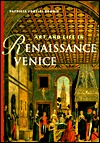

 |

|

The average rating for Canaletto and the Venetian vedutisti based on 2 reviews is 3.5 stars.
Review # 1 was written on 2020-08-24 00:00:00 Kevin Hall Kevin HallI've had this book for 20 years but, like most of my art history books, never actually read much of the text, until quarantine got me digging deep into my home library. Since this book is more of a study of Venetian society via art than an art history proper, it does not contain many of the most celebrated masterpieces of Venetian painting, but many more minor works which illuminate interesting aspects of Venice life. And that's great, because those celebrated masterpieces are reproduced everywhere and these less famous works are not. I feel like by now Venice has some kind of "theme park" stigma among "sophisticated travellers": who but a tourist would go to a phony town like Venice instead of an "authentic" village in Thailand or something? But take one step back from middlebrow bourgeois striving and you'll remember that the place is a bizarre and fascinating phenomenon, and even if you have to share it with people who don't list "travel" and "hiking" on their Tinder profiles, the art produced there in the Renaissance was some of the most incredible the world has ever seen. I hope someday the virus is under control, I have a job again, and I can make it over there, to see it in person. |
Review # 2 was written on 2017-02-22 00:00:00 Paul Viapiana Paul Viapiana2.5, rounded up to 3 A solid book with beautiful illustrations. Art history jargon (how many times can you use the word "pastiche?") infects the prose, but it is full of interesting tidbits. One section I enjoyed was on how the city's history of mosaics influenced the local artists' paintings, starting with Paolo da Venezia, followed by Bellini and Titian. Figuring out authorship in the Renaissance is always a challenge, but Brown makes the case that it was more challenging than usual in Venice, where the local artists frequently worked together on monumental city commissions. Norwich's "A History of Venice" often referred to the "scuole" in Venice, but Brown explained their role in Venetian life. They were large religious communities, with the emphasis on community. They included both men and women, and they were economically mixed. They would have probably been the only places elite women could have a social life, and they ensured that people from different social classes interacted. I also enjoyed her chapter "Private Worlds," which used the art of the time to figure out what house interiors looked like. This section also discussed some of the artisan products of Venice (fine cloth, especially brocade, and lace), which helped make Venice an economic powerhouse. Lastly, the "Class, Caste, and Gender" chapter had illustrations of the unusual (to us) patrician Venetian family structure. The Venetian elite would have large families (say, fourteen children), but only one of the sons would marry. No wonder courtesans made up ~10% of the population around 1500. Norwich explained that this would keep the wealth in the clan, but Brown's use of Titian's "The Vendramin Family before the Reliquary of the True Cross" and Paolo Veronese's "Presentation of the Cuccina Family to the Madonna" show how this arrangement worked out in family life. Norwich also doesn't talk much about the role of women in Venice as compared to the rest of Italy. The more I read, it seems like the elite women of Florence and Venice were sequestered away. Women in comparable social positions had more freedom and power in other parts of the peninsula. Brown uses the Titian painting above to show how elite women were often excluded from the public sphere; it was probably better for le cittadine, or the women in the class right below the patrician families. In spite of all this fascinating information on family life, I didn't really enjoy this section because of the weird art history language around sex. For example, the sentence "her dreamy expression suggests surrender and a sensuality that gains its power from its lack of definition" on the bottom of page 157 really annoyed me. A brief note in case they publish another edition: the caption on Figure 14 may want to use "Judea," rather than "Iudea." |
CAN'T FIND WHAT YOU'RE LOOKING FOR? CLICK HERE!!!